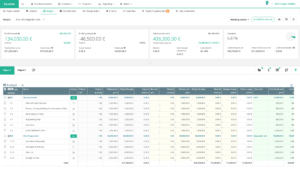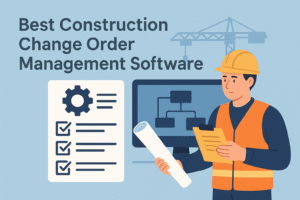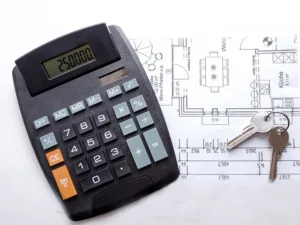Construction job costing is a precise method for determining the expenses of a project by closely examining each specific cost involved. This detailed attention allows for more accurate bidding on future projects of a similar nature and better budget management by keeping track of the various expenses in a large construction project. Additionally, accurate job costing is crucial for construction businesses as it aids in managing cash flow and safeguarding profit margins, particularly when unexpected changes or new requests arise during the course of a project.
Table of Contents
Key Takeaways
- Construction job costing is an intricate method of accounting that helps track and allocate costs to specific projects while keeping an eye on budgets.
- This method primarily categorizes costs into three types: labor, materials, and overhead, which can be classified as either direct or indirect expenses.
- Due to its detailed nature, construction job costing can be quite complex. Fortunately, financial management software is available to simplify these tasks by handling the detailed tracking and calculations.
What is construction job costing?
Construction job costing is a method used to meticulously track all expenses related to a specific construction project. This includes the cost of labor, materials, and overhead expenses. By maintaining a detailed account of every expense, this approach helps businesses monitor costs in real-time, enabling better financial management and future profitability projections.
Why Job Costing Matters in Construction
Unlike traditional accounting methods that may record expenditures broadly across a general ledger, job costing zooms in on individual projects. This specificity allows project managers to pinpoint where funds are going and quickly address any financial overruns. It makes it easier to spot unexpected costs and manage budget constraints effectively, providing a clear financial picture of each project’s profitability.
Job Costing vs. Process Costing
While job costing focuses on individual projects with detailed expense tracking, process costing is used more in manufacturing for repeated productions. Process costing accumulates costs over a long production run, suitable for products that are uniform and produced in large quantities. The stark contrast here is the granularity of financial tracking in job costing, ideal for construction projects where each job can have unique financial demands.
Is job costing the same as estimating?
No, construction job costing and construction estimating are not the same, though they are closely related and both crucial in managing a construction project’s finances. Here’s how they differ:
Construction Estimating:
- Purpose: The main objective of construction estimating is to forecast the potential costs of a project before it starts. This process involves calculating the expected costs of materials, labor, equipment, and overhead. The result is used to create a project bid or set the initial budget.
- Timing: Estimating occurs in the pre-construction phase. It’s a preliminary activity that helps contractors decide whether to bid on a project and at what price point.
- Function: Estimates are used to secure contracts by providing potential clients with a projected cost of the work. They are based on theoretical data and projections, often relying on past project data, market rates, and standard industry costs.
Construction Job Costing:
- Purpose: Job costing, in contrast, tracks a project’s actual expenses as it unfolds. It records and monitors all costs associated with a specific construction project, ensuring that the project stays on budget.
- Timing: Job costing is an ongoing process that occurs throughout a project’s duration. It starts once the project kicks off and continues until the project is completed.
- Function: The main function of job costing is to ensure financial control by continuously comparing actual costs to estimates. This helps managers make informed decisions about resource allocation, potential adjustments, and overall project management to maintain profitability.
While both processes aim to manage a project’s costs, estimating involves predicting costs before the project starts. Job costing consists of managing and tracking those costs throughout the project lifecycle. They work hand-in-hand to help construction businesses plan and manage their finances efficiently.
What is an example of construction job costing?
Imagine a construction company is tasked with building a small office building. Here’s how they might use job costing to manage the project’s finances:
- Project Budget Creation: The company begins by estimating the total costs needed for the project. They calculate the expected expenses for materials (like cement, steel, and glass), labor (wages for workers like carpenters and electricians), and overhead (such as site security and equipment rental).
- Tracking Real Costs: As the project starts, the company uses job costing to record every expense. They track the number of hours each worker spends on the project and the quantity of materials used each day.
- Cost Classification: Expenses are categorized into labor, materials, and overhead. For example, the salary of a foreman overseeing the project is classified as labor, while the cost of hiring cranes falls under overhead.
- Comparison and Analysis: Throughout the project, the company compares the actual expenses with the initial budget. If they find that the cost of steel has exceeded the estimate due to a rise in market prices, they recognize this as a variance.
- Adjustments and Reporting: Using this detailed financial data, the project manager can make informed decisions, such as finding cost-saving alternatives or adjusting the timeline to ensure the project stays within budget. They also prepare financial reports showing the profitability of the project and areas where costs were higher or lower than expected.
In this way, job costing not only helps track every dollar spent but also provides insights necessary for managing a project effectively and ensuring financial control.
How do you calculate construction job costing?
Job costing, also called project-based accounting, involves adding up costs from three main categories for any given project: labor, materials, and overhead. Here’s a simple formula to calculate the total cost of construction jobs:
Total Job Cost = Materials + Labor + Overhead
- Materials: This includes all the raw materials needed for the project, like lumber, steel, and concrete. It also covers costs related to these materials, such as transportation to the job site.
- Labor: This is calculated by multiplying the amount of time workers spend on the job by their pay rates, which could be hourly or daily.
- Overhead: These are the general business costs associated with running a construction project, including administrative expenses, marketing, and insurance. Construction companies often charge a standard overhead fee since it’s tricky to link overhead directly to specific projects. This could be a percentage of the total project costs or a fixed amount previously determined.
Using this approach, construction companies can clearly see what each project will likely cost and manage their finances accordingly.
What to Include in Construction Job Costing
When setting up construction job costing, it’s important to capture every expense related to the specific project you are managing. Job costing provides detailed insights into each expense, from the initial site work, like excavation and laying foundations, to the final project steps. Here’s a breakdown of what to include, categorized into three main types of expenses:
1. Labor: Labor typically represents the largest portion of costs in construction projects. Tracking all expenses related to your workforce, including payments to crew members and subcontractors, is essential. This encompasses hourly or daily wages, workers’ compensation, overtime payments, and other related costs.
2. Materials: Materials costs can be either direct or indirect. Direct materials include items that are part of the construction, such as wood, concrete, steel, and electrical wiring. Indirect materials might not be tied to one specific project. They could include supplies like safety equipment (gloves, helmets), adhesives (glue, tape), and other maintenance materials (lubricants), which are usually bought in bulk and used across various projects.
3. Overhead: Overhead costs are also essential to job costing, covering both direct and indirect expenses. Direct overhead is explicitly linked to a project and varies from one job to another. This could include temporary office setups on the construction site, project-specific staff salaries (like supervisors), rental costs for machinery (cranes, bulldozers), permits, and sanitation services. Indirect overhead refers to the general costs of running your business that aren’t tied to a specific project, such as marketing, office supplies, and other routine business expenses.
Including these detailed categories in your job costing helps ensure you have a complete financial snapshot of each project, allowing for effective management and decision-making throughout the construction process.
Benefits of Construction Job Costing
Although job costing in construction can be complex, its effectiveness can significantly enhance profitability. Here are some key benefits of implementing job costing:
1. Accurate Cost Tracking — Job costing provides a precise system for recording every expense. This detailed tracking helps you understand exactly where every cent of your company’s money goes, ensuring an accurate spending account.
2. Transparent Spending — With every expense recorded, you can see your financial activity and its impact on your budget. This visibility allows you to control spending proactively, helping to prevent budget overruns before they happen.
3. Cost and Budget Comparison — This method allows you to compare your actual expenses against initial estimates. Understanding where you might have overspent or saved provides valuable insights to guide your bidding strategy on future projects, making your estimates more accurate.
4. Real-Time Budget Monitoring — By tracking every dollar, you stay continuously informed about your current spending. This immediate insight into your financial status lets you quickly address potential budget issues, preventing significant financial setbacks.
5. Profitability Analysis—After completing a project, you can analyze the total profit made. This information is crucial for determining its success and deciding which types of projects are financially worthwhile in the future.
Efficient job costing not only keeps your financial data transparent but also ensures you are always aware of financial movements within a project. It lets you spot potential risks early and make informed decisions to keep the project within budget.
Tips to Improve Construction Job Costing
Improving the accuracy and efficiency of construction job costing is crucial for managing project budgets effectively. Here are several strategies to refine your job costing process:
1. Utilize Automated Time-Tracking
Replace outdated paper timecards with automated time-tracking apps on mobile devices. This technology helps capture labor hours accurately and promptly, reducing errors associated with manual data entry and payroll processing.
2. Refine Cost Codes
In job costing, every task should have a corresponding cost code that aids in pricing and tracking expenses. These codes are crucial for organizing expenses and simplifying billing and invoicing by grouping similar costs for analysis against past projects.
3. Monitor Billing
If your contracts allow, bill your clients for expenses. Monitoring all project costs closely ensures that invoices are precise, which can significantly improve your cash flow.
4. Manage Change Orders
Change orders can disrupt your budget and affect profitability if not managed properly. Tracking these changes as part of your job costing helps you understand their financial impact and make necessary adjustments to the budget.
5. Regular Project Reviews
Successful construction firms frequently review their project costs. Job costing facilitates continuous monitoring of expenses, worker productivity, and allows for timely adjustments to stay on budget.
6. Account for Overhead Costs
Include overhead costs such as taxes, administrative expenses, and fees for professional services (e.g., legal, accounting) in your calculations. These costs are generally added as a percentage of the total labor, materials, and equipment costs.
7. Track Labor Costs
Since labor is often the most significant expense in construction projects, meticulously track all labor costs, including those for daily crews and subcontractors, as well as overtime and insurance costs.
8. Prefer Job Costing Over Process Costing
For construction projects, job costing is generally more suitable than process costing due to its detailed approach. Job costing considers all project-related costs, enhancing future estimates and identifying improvement areas. Process costing suits businesses that mass-produce goods.
9. Double-Check Your Calculations
Implement a practice of double-checking all cost calculations, possibly with a second knowledgeable person reviewing the figures. This also applies to estimates from subcontractors and matching revenues against estimates for labor, materials, and overhead.
10. Invest in Construction Accounting Software
To manage the complex tracking and recording of materials, labor, and overhead costs efficiently, invest in robust construction accounting software. This technology enables the precise assignment of expenses to specific codes and projects, offers detailed insights into where funds are spent and maintains historical data to inform bids on future projects.
By adopting these strategies, construction businesses can achieve more precise job costing, better project management, and improved profitability.
How to Build a Construction Job Cost Structure
Creating a job cost structure in construction is essential for precise financial management. It allows you to track every dollar by categorizing it according to its specific purpose within a project. Here’s how to build an effective job cost structure:
1. Define Jobs: The first step is to define each project or job. Each job should be considered its own entity, with all associated costs tracked separately to calculate profitability accurately. For example, if a construction company is scheduled to build a supermarket, construct a bridge, renovate part of a mall, and erect a recreation center, each project would be treated as a separate job with its own set budget and tracked expenses.
2. Break Down Jobs into Phases: Each job is divided into different phases, which are the major steps required to complete the project. These might include phases like site preparation, foundation laying, framing, and interior finishing. Each phase needs to be clearly defined to manage costs effectively. For instance, if a company is building a recreation center, the phases might include land clearing, foundation laying, structural framing, and interior decoration.
3. Establish Cost Codes: Within each phase, further break down the costs into cost codes. These codes represent specific tasks or types of expenses incurred during a phase. For instance, in the phase of interior furnishing, cost codes could be set for clearing the site of tools, final cleaning, furniture installation, and official inspections.
4. Detail Costs in Classes: The most detailed breakdown in the job cost structure involves classes. This categorization goes into the minutiae of every expense, specifying precisely what each cost is for and how it is applied. In a framing phase, for example, you might have classes for labor (number of workers and hours worked), materials (quantities of lumber and nails used), equipment (rental and fuel costs for machinery), and other specific costs such as project management or transport.
5. Allocate Overhead: Ensure overhead costs are factored into your job cost structure. These might include general administrative expenses, insurance, and workers’ compensation, typically calculated as a percentage of labor or total project costs.
6. Monitor and Adjust: As the project progresses, it’s crucial to continuously monitor costs against the budget and make adjustments as needed. This real-time tracking helps prevent budget overruns and ensures the project’s financial health.
Example in Practice:
Consider a construction company, Company Alpha, working on various projects. For a specific project, like building a library, the job cost structure might track costs as detailed as $200 spent on electrical cables specifically for wiring during the ‘Interior Trades’ phase.
Creating such a detailed job cost structure allows construction companies to see where money is being spent, identify any financial discrepancies, and make informed decisions about optimizing costs. While not every company will need such a detailed cost structure, the ability to drill down to specific expenses is invaluable for those facing frequent budgeting errors.
Streamline Job Costing with Construction Job Costing Software
Managing job costs in the construction industry is crucial to keep your construction business profitable. Manual job costing can be tedious and error-prone, often involving extensive use of detailed spreadsheets. Construction job costing software streamlines this process, enhancing accuracy and manageability. With this software, expenses can be immediately assigned to specific projects using pre-set cost codes. This allows for real-time monitoring of project progress, eliminating the need to wait until project completion or to manually update spreadsheets to track financial performance.
Construction job costing is a precise method used to calculate the costs associated with construction projects, categorizing expenses into labor costs, material costs, and overhead costs. This method not only tracks the progress and efficiency of a project but also provides vital data that helps in making well-informed business decisions. By leveraging construction job costing software, you gain access to historical cost data, which can facilitate quicker and more accurate estimates for future projects, ensuring better project management and profitability. Calculate job costing with Bauwise!
About the Author

Taavi Kaiv
Taavi Kaiv is a construction specialist with over ten years of experience in the construction industry. Taavi is an accomplished construction project manager with many successful projects that have been completed under his guidance. Taavi holds a master’s degree in construction management from the Tallinn University of Technology. View profile






